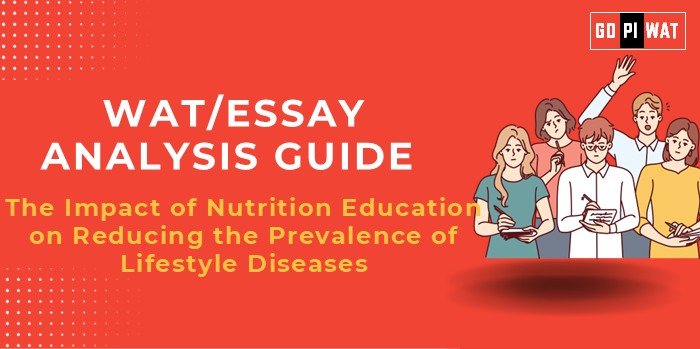📋 Written Ability Test (WAT) Analysis Guide
🌟 Topic: The Impact of Nutrition Education on Reducing the Prevalence of Lifestyle Diseases
🌐 Understanding the Topic’s Importance
Nutrition education connects healthcare with economics by reducing the burden of lifestyle diseases, aligning with the triple aim of better health, lower costs, and improved patient experience.
📝 Effective Planning and Writing
- Time Allocation:
- Planning: 5 minutes to brainstorm structure and examples.
- Writing: 20 minutes for the main draft.
- Review: 5 minutes for corrections and enhancements.
- Preparation Tips:
- Gather relevant data (e.g., obesity rates, program outcomes).
- Identify key stakeholders and successful interventions.
✨ Introduction Techniques for Essays
- Contrast Approach: “While lifestyle diseases are on the rise, nutrition education remains an underutilized solution.”
- Solution-Based Approach: “Investing in nutrition education is a cost-effective way to tackle the growing epidemic of lifestyle diseases.”
🔍 Structuring the Essay Body
- Paragraph 1: Achievements
- Highlight success stories like Finland’s reduction in heart disease or India’s POSHAN Abhiyaan.
- Paragraph 2: Challenges with Comparative Analysis
- Discuss cultural resistance and affordability while referencing global examples like the U.S. and Japan.
- Paragraph 3: Future Outlook
- Emphasize integrating technology and policy reforms to enhance the impact of nutrition education.
✅ Concluding Effectively
- Balanced Perspective: “Nutrition education is a crucial but insufficient solution; systemic support is needed to achieve tangible results.”
- Global Comparison: “Learning from nations like Japan and Finland, India can develop a multi-faceted approach to curb lifestyle diseases.”
📄 Sample Short Essays
- Balanced Perspective: “Nutrition education empowers individuals with knowledge to make healthier choices, yet its success depends on supportive policies and affordability.”
- Solution-Oriented: “Promoting nutrition education is a cost-effective way to reduce healthcare expenses and improve public health outcomes.”
- Global Comparison: “From Finland to Japan, countries have demonstrated how nutrition education can transform public health and reduce lifestyle diseases.”


